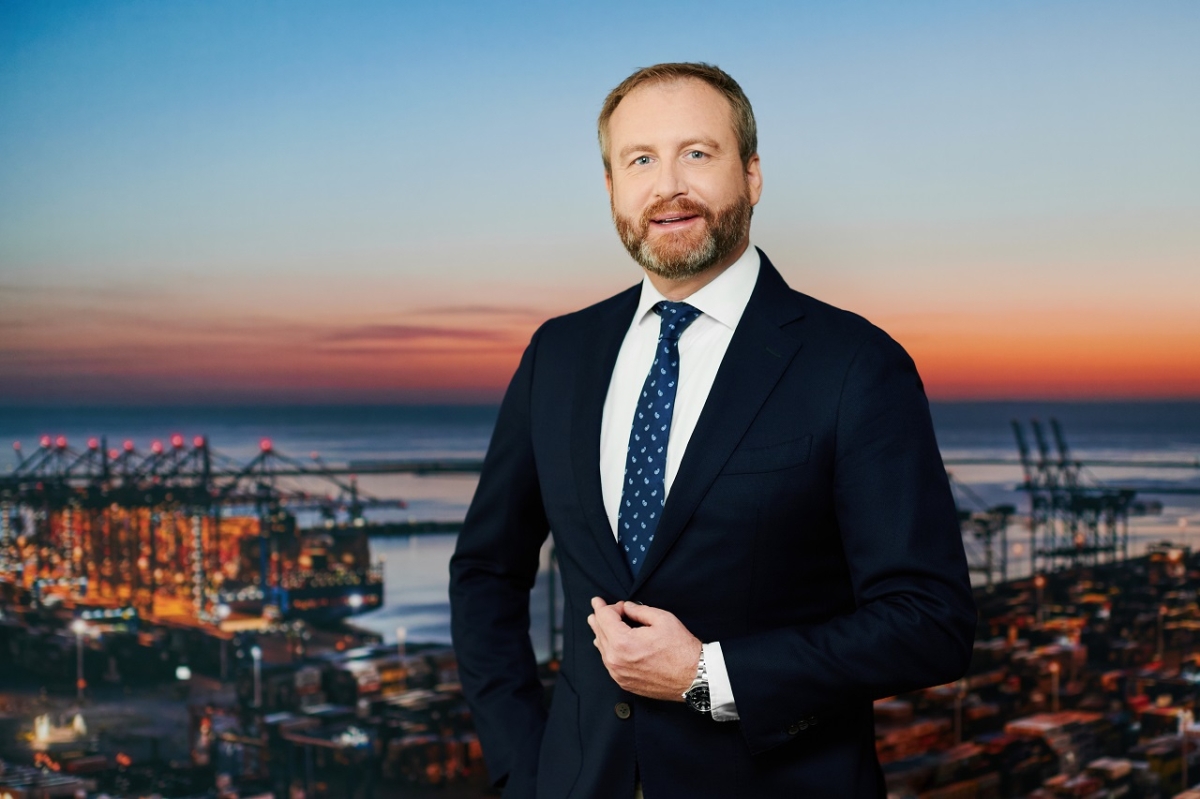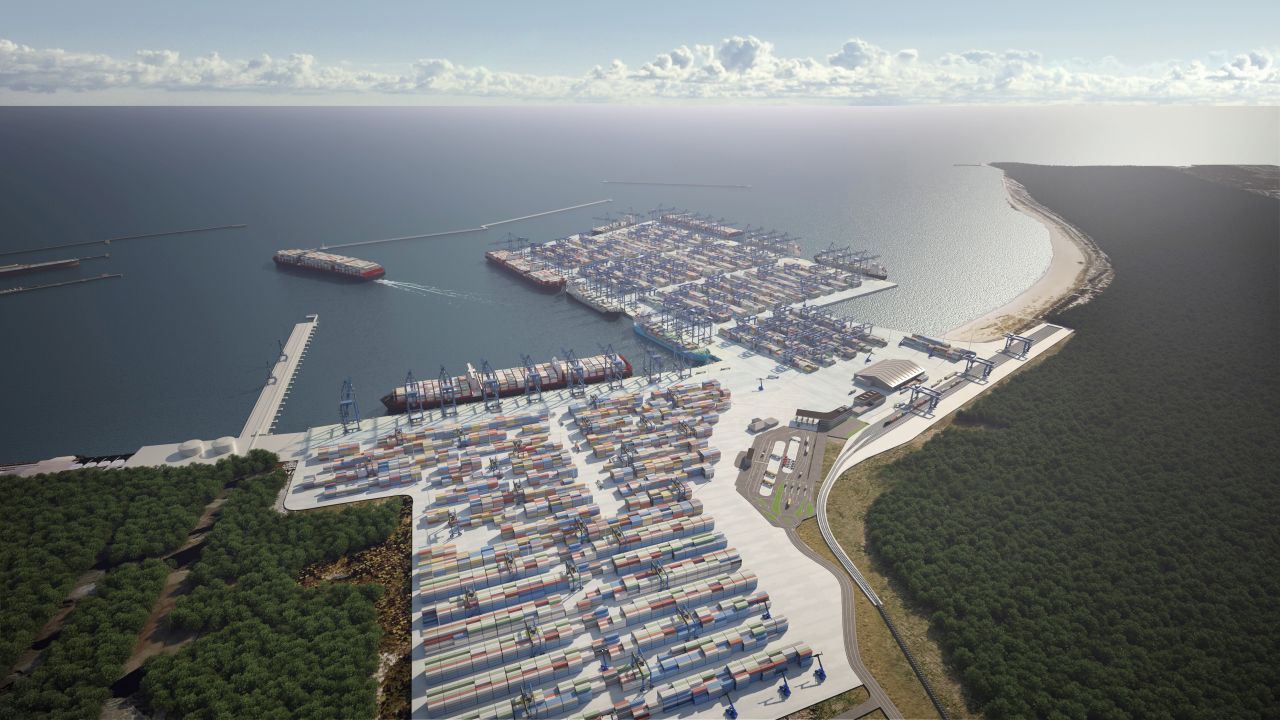
– We want to be one of the largest container hubs in Europe and this will happen within a few years. Given our excellent location and operational capabilities, we want to be a leading player in the region, both from land and sea - says Charles Baker, managing director of Baltic Hub (DCT Gdańsk) in an interview with GospodarkaMorska & Marine Poland.
Anna Konopka: At the end of
October, DCT Gdańsk announced its rebranding, changing its name to
Baltic Hub. What does this mean in practice?
Charles Baker: The introduction of a new name and brand is a kind of response to our dynamic development. Over the last 15 years, i.e. since our establishment, we have become the fastest growing container terminal in the Baltic Sea. We started our history as a Deepwater Container Terminal (DCT) to become the largest terminal complex in the Baltic.
And the terminal, although
already the largest in the Baltic Sea, wants to be even stronger and
develop new possibilities.
With the completion of the
construction of our third deep-water quay by 2025, we will
consolidate the position of the hub and become one of the largest
complexes of container terminals in Europe. So we could still use the
name DCT for a deep-water container terminal, but at the current
stage of the company's development, the name Baltic Hub definitely
reflects reality more.
Changing the name and brand is also
a response to the development of our infrastructure on land and the
connections we have created, becoming the main transport gateway to
Central and Eastern Europe. Today we have excellent land connections
with countries such as the Czech Republic, Slovakia, Ukraine, Hungary
and Germany. In conclusion, we decided to highlight our exceptional
growth and what we have achieved in just 15 years. At the same time,
we present current development plans by changing the name - from DCT
to Baltic Hub.
What will the third deepwater
terminal, the so-called T3?
As for the T3, we just started
building it. It is a deep-water quay with a length of 717 m, a depth
of 17.5 m and a yard with an operating area of 36.5 ha. The T3
project additionally includes the purchase of 7 wharf cranes, capable
of handling the largest ships in the world, and 20 semi-automatic RMG
cranes operating in the container yard. The new terminal will be
built entirely on water, and its buildings will be adjacent to T1,
which will be a continuation of our development at sea.
The enlargement of the terminal
will translate into transshipment possibilities. How will the
functioning of the Baltic Hub change after the construction of the
third quay?
In 2024 and 2025, the transshipment
capacity of the Baltic Hub will increase by 1.5 million to
approximately 4.5 million TEU, and this is already the amount that
the largest port complexes can boast of. Thanks to this investment,
our container hub will become one of the largest in Europe, capable
of handling the latest generation of container ships entering the
Baltic Sea.
Currently, in Poland, only our T2
quay can handle 400-meter ships sailing on trade routes from Asia to
Europe. At the moment, this wharf is already developed thanks to
cooperation with the shipping alliances 2M and Ocean Alliance. If,
for example, a third weekly service needs to be launched with these
largest vessels, there is no longer room to accommodate them until T3
opens. In addition, many new ships are under construction, so an
increase in large-scale cargo handling capacity is desperately
needed.

The contract for the expansion of the terminal has already been signed, and the project is expected to be completed in the second quarter of 2025. What will happen as part of the work in the coming months?
The construction of T3 will be
divided into two stages. A consortium of Budimex and Dredging
International (DEME) is now carrying out dredging and reclamation
work to create the platform that will be the base of the future
terminal. At the same time, piling will start, as a result of which a
quay will be built with a length of 717 m and a depth of 17.5 m.
Handling capacity will increase gradually as equipment is
successively delivered from contractors. The delivery of the first
quay cranes is planned for the first quarter of 2024. We hope that
the first ship will be serviced at the new quay in mid-2024, and the
works will be fully completed in mid-2025.
Ports play a special role during
the ongoing war in Ukraine. How does this conflict affect the Baltic
Hub?
The geopolitical situation will
always affect trade and consumer confidence. The Baltic Hub acted as
a hub for Russian imports and exports, which was connected with liner
ships from the Far East. This cargo flow has been stopped due to the
ongoing situation and will not resume until sanctions are eased.
Nevertheless, the market is surprisingly resilient and lost volumes
have been replaced by a combination of other Baltic destinations,
imports and exports of Polish cargo, and even cargo going to Ukraine
as Ukrainian ports remain closed. Of course, we hope for a peaceful
resolution of the ongoing conflict and a return to stability on world
markets.
A month ago, 15 years passed
since the official opening of the terminal. This time translated into
over 15 million TEU transshipped since the beginning of the
terminal's operation. 700 ships entered it annually, including 100
calls made by the largest container ships in the world. What are the
biggest challenges for the Baltic Hub for the coming years?
Since the launch of the terminal 15
years ago, we have recorded impressive growth, starting with one
deep-water berth and a handling capacity of up to 500,000 TEU, to
become a real hub in the Baltic Sea in 2021 with two deep-water
berths that handled over 2.09 million TEUs. At the moment, Baltic Hub
has quays with a total length of 1,300 meters, 14 STS (ship-to-shore)
cranes and an annual capacity of 2.9 million TEU. We have done a lot
to make Baltic Hub the fastest growing container terminal in the
Baltic Sea. This is the result of the excellent location of our hub,
with good access to the sea and no tidal restrictions, excellent
operational capabilities as well as support and investment in
infrastructure from the Polish government.
It must be said that since the
emergence of Covid-19 in 2020, global supply chains have been
colliding with successive crises, with Russia's war with Ukraine
having an impact on inflation, through higher energy prices and
market uncertainty. When it comes to investments and increasing our
capacity, with such reliable and experienced partners as Budimex and
Dredging International NV in the construction of T3, we are sure that
we will meet the timeframes set for the implementation of the
investment. In our opinion, this is important for maintaining an open
and free flow of the supply chain for Polish importers and exporters.
Another challenge we face is the
situation on the labor market in the region - this market is
tightening, especially in the case of some skilled technical
professions, such as computer scientists and technicians.
What can we expect in this area
in 2023?
Thanks to investments in T3, in
2023 Baltic Hub will introduce semi-automatic cranes that will ease
the pressure on the labor market and change the nature of work. This
means that we will be able to adjust shift start and end times for
some employees.
Baltic Hub's biggest ambitions
for the near future are…
As I mentioned earlier, we recently
changed our name and brand to reinforce our ambition to be "The
Baltic Hub". We want to be one of the largest container hubs in
Europe and this will happen within a few years. Given our excellent
location and operational capabilities, we want to be a leading player
in the region, both by land and sea, able to compete on equal terms
with major Western European ports such as Hamburg, Rotterdam and
Antwerp.


